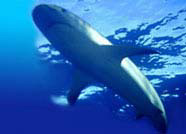


Shark Glossary

 |
 |
 |
|||
| Home | Evolution
| Classification
| Glossary | Biology
| Behavior | Shark
Repellent | Shark
Conservation | Do's &
Don'ts | Did You Know?
Shark Glossary |
 |
||||
|
Hammerhead Shark
Hammerheads are sharks with odd, wide, elongated heads. They eat fish, including rays, other sharks, squid, octopuses, and crustaceans. It has been known to be cannibalistic. Order Carcharhiniformes.  Heart Sharks have a two-chambered heart, with an atrium (also called the auricle) and a ventricle. The heart is an S-shaped tube that is located in the head region of the shark. The blood is pumped by the heart through the afferent branchial arteries (ventral aorta) to capillaries in the gills (where the blood is oxygenated). The blood then flows through efferent branchial arteries (paired dorsal aorta), then through the tissues of the body, and then back to heart in veins.
 Helicoprion HelicoprionHelicoprion was an ancient fish from the Late Paleozoic (it appeared during the Carboniferous period, about 345 million years ago). This predatory fish is known only from fossilized teeth; it probably had a cartilaginous body (which does not fossilized well and is possibly why a fossil skeleton from this fish has not been found). Helicoprion was probably related to sharks or was a shark itself. It had big, flattened teeth that were probably used for crushing shellfish and arthropods. These teeth grew in a series of coiled whorls; new teeth relaced broken and worn-out teeth, but the old ones went inside the jaw. These fossilized teeth have been found worldwide. Classification: Family Edestidae. Hemipristis  Hemipristis is a genus of sharks that are also called "snaggletooth sharks" (because of their extremely serrated teeth). Hemipristis elongatus is a modern-day . Hemipristis serra (named by L. Agassiz in 1843) was a Miocene Epoch snaggletooth shark that lived about 24 million to 5 million years ago; it is known only from fossilized teeth. Classification: Order Carcharhiniformes, Family Hemigaleidae (weasel sharks), Genus Hemipristis (snaggletooth sharks), many species. Heterodontiformes A clade of shark that has an anal fin, 5 gill slits, 2 dorsal fins, and dorsal fin spines. These include the bullhead and horn sharks. Hexanchiformes A clade of shark that has an anal fin, 6-7 gill slits, and 1 dorsal fins. These include the frilled and cow sharks. Hooktooth Dogfish Shark The hooktooth dogfish shark, Aculeola nigra, is a tye of dogfish shark with 60 rows of hook-shaped teeth. This shark is about 60 cm long. This bottom dweller lives in deep parts of the eastern Pacific Ocean. Its skin is black to deep charcoal in color but the tips of the fins are white. Order Squaliformes. Horn Shark  Heterodontus francisci, the California horn shark is a bottom-dwelling fish that grows to be about 3 to 4 feet (0.9 to 1.2 m) long. It has rounded fins, a blunt snout, ridges over the eyes, a dorsal fin spine, and is light brown with dark brown spots. It lives in kelp beds far offshore California, USA, spending a lot of time resting on the bottom. This slow-moving shark is harmless to people, but its spines do sting when they are touched. It hunts at night and eats sea urchins, crabs, worms, anemones, and other bottom-dwelling invertebrates. It has small, pointy teeth in the front of its mouth, and flat teeth in the back (these are good for grinding hard-shelled prey). It is oviparous, laying corkscrew-shaped eggs in rock crevices. These eggs are about 4 3/4 inches (12 cm) long and take from 6 to 10 months to hatch; the time depends on the temperature of the water. Classification: Order Heterodontiformes. Hybodus  Hybodus is a genus of extinct sharks from the Carboniferous period, that lived from the Triassic period until it went extinct during the huge K-T mass extinction 65 million years ago, when the dinosaurs died. This hybodont had fin spines, an anal fin, a blunt snout, and a long body. It had sharp teeth at the front of the jaws (for catching fish) and blunt teeth towards the back (for crushing shellfish). Hybodus was about 7.5 feet (2.5 m) long. Hybodus tooth fossils are found worldwide. |
|
||||||||||||||
| Sitemap | Reach To Us | Jimtrade - Business Directory of India | |||||||||||||||